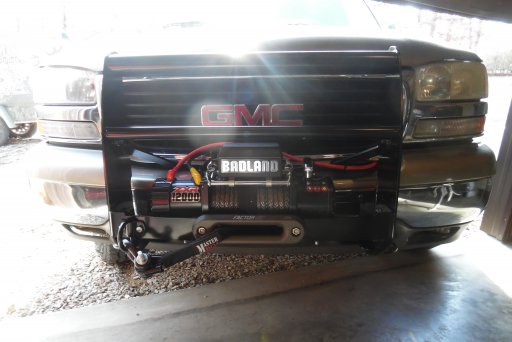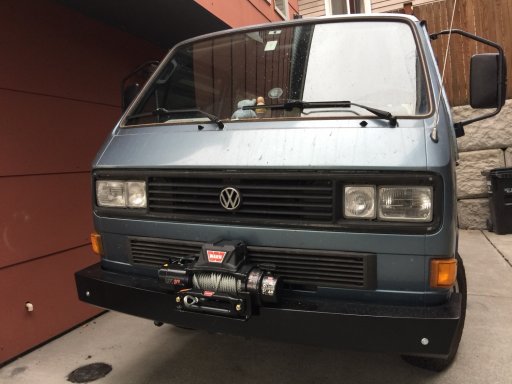-
Guest, UPDATE We went through the site migration runbook and completed all steps. We will need to complete the migration next week, but will leave the forums up for the weekend. A few days after maintenance, a major upgrade revision to the forum site will occur.
-
Winch powered by Starting or Auxiliary power? What do you recommend?
- Thread starter kengineer
- Start date
Dakota Houligans
Rank IV

Enthusiast II
A starting batter usually has higher cranking amps that in can apply quickly so it will run a winch better. And it usually is the one with a direct and heavier gauge charge wire run to it.

Benefactor
As others have said, the starter battery is the way to go.

Member I
WILLD420
Rank I

Enthusiast I
There are a couple schools of thought on this. I've always run from the aux battery because I want the voltage to stay more even in the battery connected to the ECM and the alternator directly. I don't know if it actually works but I've seen vehicles die when winching really hard because the battery voltage goes below 9 volts when the winch stalls or is started under heavy load and the capacity isn't high enough for all of the loads going on. I also run my batteries connected full time as the majority of the isolators I have seen or heard about do not seem to work as advertised. If I was running a fridge, I would probably do something different so I could pull from both batteries at the same time while winching and keep them separate to prevent killing the whole system if I camped too long without charging. I am also a big believer in upgrading the alternator charge line and speeding the engine up during winching.
Speeding the engine up may not charge a lot more amps but it runs the alternator fan a lot faster and any electric person can tell you an alternator or electric motor likes airflow and speed under heavy load. Less time per revolution that each winding has to carry the whole load and the alternator fan moves a lot more air at 2K rpm than it does at idle.
Speeding the engine up may not charge a lot more amps but it runs the alternator fan a lot faster and any electric person can tell you an alternator or electric motor likes airflow and speed under heavy load. Less time per revolution that each winding has to carry the whole load and the alternator fan moves a lot more air at 2K rpm than it does at idle.
madcratebuilder
Rank V

Pathfinder I
I like a direct connection the the main battery and I use Anderson connectors . Winch only has power when I want it to. I do not want a fuse, relay or other possible fail point in the winch circuit.

Traveler I
I haven’t figured out what I’m doing for a fuse, but I’m definitely adding one. Not having one is too big of a fire risk for me to be comfortable. I guess going fuseless would be okay if it was not connected unless I was out on the trail...I like a direct connection the the main battery and I use Anderson connectors . Winch only has power when I want it to. I do not want a fuse, relay or other possible fail point in the winch circuit.
madcratebuilder
Rank V

Pathfinder I
I've seen complex winch wiring fail and cause smoke to escape. With the Andersons I just plug and unplug as needed, takes all of ten seconds. I did move the controller box from the winch to the engine bay, keeps it dry and out of the weather.I haven’t figured out what I’m doing for a fuse, but I’m definitely adding one. Not having one is too big of a fire risk for me to be comfortable. I guess going fuseless would be okay if it was not connected unless I was out on the trail...

Expedition Master III
When I had my winch installed, this same concern crossed my mind. I have a GM/CHEVY, so it would take extra time to disconnect the side mounted battery cables vs a older style top mount cable.I've seen complex winch wiring fail and cause smoke to escape. With the Andersons I just plug and unplug as needed, takes all of ten seconds. I did move the controller box from the winch to the engine bay, keeps it dry and out of the weather.
As many are aware, GM has their dual battery systems run in series, with no isolator. Great for extra AMP storage, but bad when your batteries are weak. Your first clue to a problem is the obvious drain, when it is basically to late. When i bought my truck, the dual alternator option was only about $220. Looking back, I should have invested in it. Retrofitting now will be an expensive upgrade. Bought a 17,500 lb. winch to mitigate a 'underpowered or too small a winch', as well as a better safety factor for my full size 2500 HD Duramax!.
With that in mind I had a H/D switch mounted directly into the top of my ARB winch bumper. This way I can just twist it off if there is a problem. I leave it in the "off" position when I am not using the winch. This also isolates the winch in case of a battery drain. Purchased thru Amazon....it was about $18. In the end... cheaper than the Anderson connections....AND... the Chinese knock-offs.
Last edited:

Member III
I also put my winch on the aux battery.
1) If for whatever reason I cant run the engine during the recovery, Id rather strain the aux battery than the starting battery.
2) Even with the engine running, I also liked the idea if the aux acting as a "buffer" between the high draw and the main battery and control circuits.
3) However, the isolator I used (and will use again on my new truck) is rated at 150 amps continuous, and 1500 amps instantaneous. I called the manufacturer and asked about winching loads through the isolator--specifically if the winch stalled as the aux battery completely died, and tried to pull 400+ amps through the isolator. They said that wouldnt hurt it at all. So, worst case, the main battery is still available to supply as much power as needed to supplement whatever the aux can't do on its own.
I will be doing it the same way the next time around as well.
1) If for whatever reason I cant run the engine during the recovery, Id rather strain the aux battery than the starting battery.
2) Even with the engine running, I also liked the idea if the aux acting as a "buffer" between the high draw and the main battery and control circuits.
3) However, the isolator I used (and will use again on my new truck) is rated at 150 amps continuous, and 1500 amps instantaneous. I called the manufacturer and asked about winching loads through the isolator--specifically if the winch stalled as the aux battery completely died, and tried to pull 400+ amps through the isolator. They said that wouldnt hurt it at all. So, worst case, the main battery is still available to supply as much power as needed to supplement whatever the aux can't do on its own.
I will be doing it the same way the next time around as well.
A lot depends up on what batteries you have, how they are wired and what you want achieve.
I use identical batteries. I connect the winch to the Aux in both.
The aux battery always has more power, since it is doing less. I have seen folks connect to the starting battery, then when done winching could not start the vehicle (or it died during winching and could start), and had to jump or swap starting/aux batteries. This is even more of an issue in newer vehicles which need higher voltage to pressurize the injectors which found out on my Duramax. So I do everything to preserve the starting battery, to even include an isolator.
I use identical batteries. I connect the winch to the Aux in both.
The aux battery always has more power, since it is doing less. I have seen folks connect to the starting battery, then when done winching could not start the vehicle (or it died during winching and could start), and had to jump or swap starting/aux batteries. This is even more of an issue in newer vehicles which need higher voltage to pressurize the injectors which found out on my Duramax. So I do everything to preserve the starting battery, to even include an isolator.

Expedition Master III
Please eloaborate on a ISOLATOR for the GM/Chevy trucks. I have a 2003 Duramax, and before that a 1985 F150 4x4 that i added a isolated dual battery system that allowed me to jump the starter battery from the aux. battery. There has been 2 times that my batterys went flat in my Silverado, along with a slow starter,which only manifested itself at that point.A lot depends up on what batteries you have, how they are wired and what you want achieve.
I use identical batteries. I connect the winch to the Aux in both.
The aux battery always has more power, since it is doing less. I have seen folks connect to the starting battery, then when done winching could not start the vehicle (or it died during winching and could start), and had to jump or swap starting/aux batteries. This is even more of an issue in newer vehicles which need higher voltage to pressurize the injectors which found out on my Duramax. So I do everything to preserve the starting battery, to even include an isolator.
I was not aware (electrical newbie) that a dual battery isolator system was possible without some kind of elaborate rewire! So please do a follow up on what was involved...thx
Well the lo-tech solution is to put a battery on/off switch in line on your aux battery cables. Wrangler Power Products makes a kit.Please eloaborate on a ISOLATOR for the GM/Chevy trucks. I have a 2003 Duramax, and before that a 1985 F150 4x4 that i added a isolated dual battery system that allowed me to jump the starter battery from the aux. battery. There has been 2 times that my batterys went flat in my Silverado, along with a slow starter,which only manifested itself at that point.
I was not aware (electrical newbie) that a dual battery isolator system was possible without some kind of elaborate rewire! So please do a follow up on what was involved...thx







